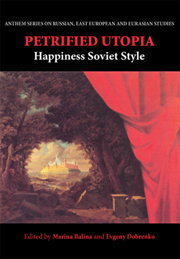Book contents
- Frontmatter
- Contents
- List of Illustrations
- Acknowledgments
- List of Contributors
- Introduction
- Petrified Utopia
- Part One Utopics
- Part Two Realities
- Part Three Locations
- 9 The ‘New Moscow’ and the New ‘Happiness’: Architecture as a Nodal Point in the Stalinist System of Value
- 10 Andrei Platonov's Happy Moscow: Tolstoi, Stalin and the Soviet Self
- 11 ‘But Where is Your Happiness, Alevtina Ivanovna?’: New Debates about Happiness in the Soviet Films of 1956
- 12 Easy on the Heart; or ‘Strength Through Joy’
- Notes
- Index
12 - Easy on the Heart; or ‘Strength Through Joy’
from Part Three - Locations
Published online by Cambridge University Press: 05 March 2012
- Frontmatter
- Contents
- List of Illustrations
- Acknowledgments
- List of Contributors
- Introduction
- Petrified Utopia
- Part One Utopics
- Part Two Realities
- Part Three Locations
- 9 The ‘New Moscow’ and the New ‘Happiness’: Architecture as a Nodal Point in the Stalinist System of Value
- 10 Andrei Platonov's Happy Moscow: Tolstoi, Stalin and the Soviet Self
- 11 ‘But Where is Your Happiness, Alevtina Ivanovna?’: New Debates about Happiness in the Soviet Films of 1956
- 12 Easy on the Heart; or ‘Strength Through Joy’
- Notes
- Index
Summary
Glance, stare, really see!
In fact, the logocentric era (in any case, as far as the transmission of news is concerned) waned long before the advent of the period that we now call the ‘audiovisual’ age. From the moment that Daguerre and Niépce observed the effect of a ray of light on silver, mankind (without yet realising it) began to prefer image over text. Newspapers still had priority, but illustrated journals, according to the authoritative evidence of Jean-Louis Servan-Schreiber, had already learned to make use of two advantages: their news could reach ‘the sticks’ via the traveling salesman's baggage and, even more, they could make ‘national advertising coverage’ a reality.
The illustrated journals of the times when the transmission of news over distance was still in an infantile state in fact fulfilled the role of the future small screen and were its direct predecessors. They delivered viewable news to the home and made it a part of familial and societal customs.
Our topic is a comparison of two 1930s journals: the Soviet Ogonek (‘Little Fire’) and the German Berliner Illustrierte Zeitung (‘BIZ’). This will be a comparison on a basic thematic level, although this is not the only possible approach, and maybe not even the most interesting.
- Type
- Chapter
- Information
- Petrified UtopiaHappiness Soviet Style, pp. 239 - 262Publisher: Anthem PressPrint publication year: 2009



